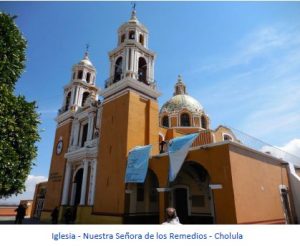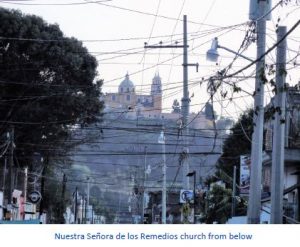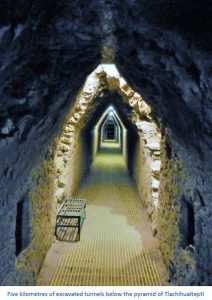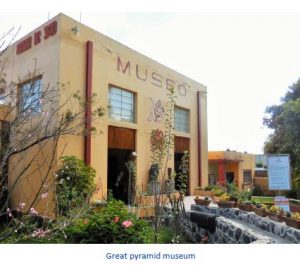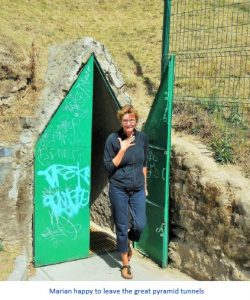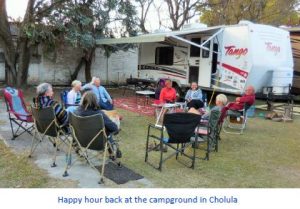By Dan and Lisa Goy from the March 2017 Edition
Days 60-63 (March 6-9, 2016)
After a few days visiting Oaxaca City, we were off to Puebla City led by Roland and Janice. Fortunately, it  was a Sunday. Traffic was light and the quota/toll road (Hwy 135D then Hwy 150D) was great. We picked this up on the north side of town. Not much to report other than beautiful vistas and panoramic views as we as we drove across the mountains. On our drive from Oaxaca to Puebla, it became apparent that the Class C (Ford E450) driven by Rafael and Eileen had developed transmission problems. This was not a transmission failure as such, more likely some internal solenoid problems. Fortunately, Grant had a can on transmission magic fluid which seemed to help and we were able to continue.
was a Sunday. Traffic was light and the quota/toll road (Hwy 135D then Hwy 150D) was great. We picked this up on the north side of town. Not much to report other than beautiful vistas and panoramic views as we as we drove across the mountains. On our drive from Oaxaca to Puebla, it became apparent that the Class C (Ford E450) driven by Rafael and Eileen had developed transmission problems. This was not a transmission failure as such, more likely some internal solenoid problems. Fortunately, Grant had a can on transmission magic fluid which seemed to help and we were able to continue.
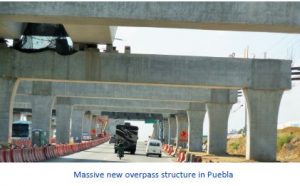 Our destination was the Las Americas RV Park in Cholula, a community adjacent to Puebla. We made good time, arriving at about 3 pm with no missteps or wrong turns. We even encountered a significant road construction project (a massive express overpass across Puebla City).
Our destination was the Las Americas RV Park in Cholula, a community adjacent to Puebla. We made good time, arriving at about 3 pm with no missteps or wrong turns. We even encountered a significant road construction project (a massive express overpass across Puebla City).
After setting up the RVs, Rafael and Grant immediately set out to make arrangements get the Class CRV to a mechanical shop which they found nearby. While the repair was underway, they stayed with Grant and Anita for a couple of nights in their Class A Motorhome. Four days later, on the evening prior to our de-parture, the vehicle returned with a nearly new transmission for $2,300.00 CDN, ready to go. Rafael and Eileen never had any more problems with the transmission or the vehicle.
Also shortly after arrival, we called a meeting to review our remaining schedule and make some  adjustments. Hard to believe we were on the last third of our 90-Day Mexican Adventure. Later, a number of us went out in search of dinner and we stumbled upon a Family Day Celebration in the Cholula Zócalo and a little hole in the wall restaurant. As we were driving around, we had our first look at ‘The Great Pyramid” (Tlachihualte), the Church sitting on top (Nuestra Senora de los Remedios) and the Popocatepetl and Iztaccihuatl volcanoes.
adjustments. Hard to believe we were on the last third of our 90-Day Mexican Adventure. Later, a number of us went out in search of dinner and we stumbled upon a Family Day Celebration in the Cholula Zócalo and a little hole in the wall restaurant. As we were driving around, we had our first look at ‘The Great Pyramid” (Tlachihualte), the Church sitting on top (Nuestra Senora de los Remedios) and the Popocatepetl and Iztaccihuatl volcanoes.
The next day, we met with the pre-arranged guide for Puebla City, a good friend of Antonio Resendiz from Bahia de Los An-geles on Baja, named Carlos. Carlos arrived with another guide, Alberto, a real expert in pre-Columbian and Colonial history. They provided us with a terrific two days of touring in both Puebla City 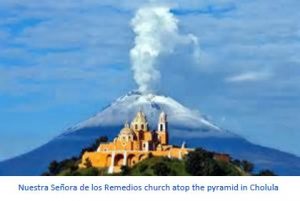 and Cholula next door. We visited many of Puebla’s famous churches, said to have 365 (you could visit a different one every day), the historic Puebla City downtown core, an extensive tour of the “Great Pyramid” in Cholula, a couple of different shops making the unique Talavera pottery and Fort Loreto with an overlook of the famous Battle of Puebla.
and Cholula next door. We visited many of Puebla’s famous churches, said to have 365 (you could visit a different one every day), the historic Puebla City downtown core, an extensive tour of the “Great Pyramid” in Cholula, a couple of different shops making the unique Talavera pottery and Fort Loreto with an overlook of the famous Battle of Puebla.
During the French intervention in Mexico on 5 May 1862, in the Battle of Puebla, defending Mexican forces under Ignacio Zaragoza, Mexico defeated the French army under Count de Lorencez, which was considered to be the most powerful in the world at the time. Moving on from Veracruz towards Mexico City, the French army encountered heavy resistance from the Mexicans close to Puebla, at the Mexican forts of Loreto and Guadalupe.
The 6,000 strong French army attacked the much smaller and poorly equipped Mexican army of 2,000. Yet, 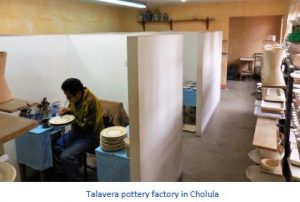 on May 5, 1862, the Mexicans managed to decisively crush the French army. Cinco de Mayo (pronounced: [ˈsiŋko ðe ˈmaʝo]; Spanish for “Fifth of May”) is a celebration held on May 5. The date is observed to commemorate the Mexican Army’s unlikely victory over French forces at the Battle of Puebla on May 5, 1862, under the leadership of General Ignacio Zaragoza. The city’s name was changed to Puebla de Zaragoza in 1862, by a decree issued by Benito Juárez and the holiday “5 de Mayo” (Cinco de Mayo) is a major annual event here.
on May 5, 1862, the Mexicans managed to decisively crush the French army. Cinco de Mayo (pronounced: [ˈsiŋko ðe ˈmaʝo]; Spanish for “Fifth of May”) is a celebration held on May 5. The date is observed to commemorate the Mexican Army’s unlikely victory over French forces at the Battle of Puebla on May 5, 1862, under the leadership of General Ignacio Zaragoza. The city’s name was changed to Puebla de Zaragoza in 1862, by a decree issued by Benito Juárez and the holiday “5 de Mayo” (Cinco de Mayo) is a major annual event here.
Tuesday night, the heavy rain started and it continued almost all day as we drove with Carlos to Contla, about an hour away. We had promised Efren from Baja (blanket factory where we stop to purchase blankets, ponchos, rugs and more) that we would visit his family home where they produce all the goods we  see in his shop. We did not know what to expect and when we arrived we were welcomed with the hospitality we have en-joyed from so many Mexicans across the country over so many years.
see in his shop. We did not know what to expect and when we arrived we were welcomed with the hospitality we have en-joyed from so many Mexicans across the country over so many years.
After initial introductions, we were treated to some local refreshments and fresh baked goods. Then Efren’s father led us across the street to see where everything was made. Some of the looms were fairly modern, others predated the depression. It was a real treat to see all this in action. We learned that all the product is delivered to Baja by truck across on the ferry from Mazatlan. Next we returned and a shopping spree broke out, no negotiation required, the prices were just that good. Following all the purchasing, we sat down for lunch, prepared by Efren’s mom and sisters, then tres leches cake for dessert. Mexican’s are wonderful people and this experience made our trip extra special indeed.
We returned to Cholula and headed out to Carlos and Cotty’s house for a prearranged dinner at 6 pm.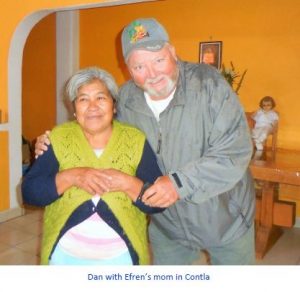 Again the hospitality was amazing, as was the food. They had prepared all locally made traditional Puebla dishes from beginning to end (including mole poblano, chiles en nogada). I lost count of how many courses. We also met their daughter, Alejandra and her baby daughter. The gals got the nana and gramma fix in for sure. What a fabulous end to our Puebla stay. We will be back again for sure. These were both fabulous experiences and speak volumes to the generosity and welcoming culture of Mexicans.
Again the hospitality was amazing, as was the food. They had prepared all locally made traditional Puebla dishes from beginning to end (including mole poblano, chiles en nogada). I lost count of how many courses. We also met their daughter, Alejandra and her baby daughter. The gals got the nana and gramma fix in for sure. What a fabulous end to our Puebla stay. We will be back again for sure. These were both fabulous experiences and speak volumes to the generosity and welcoming culture of Mexicans.
Historical Background of Puebla, Puebla
Founded in 1531, in an area called Cuetlaxcoapan, which means “where serpents change their skin”, located between of two of the main indigenous settlements at the time, Tlaxcala and Cho-lula, Puebla is located in the Valley of Cuetlaxcoapan, a large valley surrounded on four sides by the mountains and volca-noes of the Trans-Mexican volcanic belt. It is located 40 kilometres (25 miles) east of the Popocatepetl and Iztaccihuatl 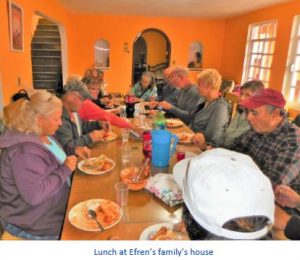 volcanoes, giving the residents a magnificent view of their snow-topped peaks. One of the volcanoes was smoking during our visit and erupted less than 2 months later. The city of Puebla is the seat of the Municipality of Puebla, the capital and largest city of the state of Puebla, and one of the five most-important Spanish colonial cities in Mexico.
volcanoes, giving the residents a magnificent view of their snow-topped peaks. One of the volcanoes was smoking during our visit and erupted less than 2 months later. The city of Puebla is the seat of the Municipality of Puebla, the capital and largest city of the state of Puebla, and one of the five most-important Spanish colonial cities in Mexico.
Puebla was an important city and region in the history of New Spain, since it was in the center region of Spanish settlement, midway between the main Atlantic port (Veracruz) and the capital (Mexico City). It had a large indigenous population and drew many Spanish settlers. It supplied the capital with com-mercially grown agricultural products and became a center of local textile production. It was well connected to Mexico’s North, particularly the silver-mining region around Zacatecas. After the city’s foundation, this valley became the main route between Mexico City and Veracruz, the port on the Caribbean coast and the connection to Spain.
The layout of the city is of classic Spanish design, centered on a main plaza, today called the Zócalo. This 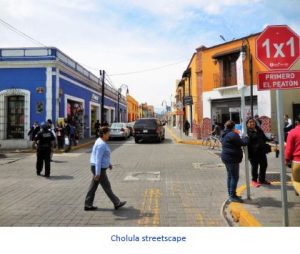 main plaza originally was rectangular, but later made square because the earlier ver-sion was considered to be ugly. Another major feature of the city is the weekly markets (tianguis), in which indigenous sellers would come with their wares and foodstuffs to sell to the population. By the mid 16th century, water was brought in to the main plaza to a newly-installed fountain.
main plaza originally was rectangular, but later made square because the earlier ver-sion was considered to be ugly. Another major feature of the city is the weekly markets (tianguis), in which indigenous sellers would come with their wares and foodstuffs to sell to the population. By the mid 16th century, water was brought in to the main plaza to a newly-installed fountain.
By the end of the century, the city occupied 120 blocks, much of which was under construction, with the new Cathedral begun in 1575. Its favorable climate and strategic location helped the city to prosper, quickly becoming the second most important city in New Spain. Juan Gutiérrez de Padilla, the preeminent 17th-century composer in the New World, spent most of his life at the Cathedral, from about 1620 to 1664.
The city council of Puebla, being made up of only Spaniards, had a certain amount of autonomy in the 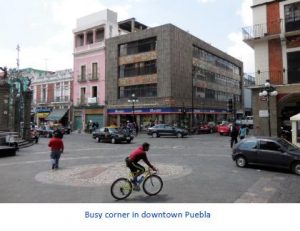 politics of the city and the land under its jurisdiction. This council annexed the towns of Amozoc, Totimehuacán, and Cuautinchán to its territory in 1755. By 1786, Puebla’s lands reached from what is now Veracruz to Guerrero states. The city continued to grow and be more regulated during the 17th and 18th centuries. A new city hall was built in 1714 and the tianguis in the main plaza was replaced by wood stalls by the 1770s. The streets were paved with stone between 1786 and 1811.
politics of the city and the land under its jurisdiction. This council annexed the towns of Amozoc, Totimehuacán, and Cuautinchán to its territory in 1755. By 1786, Puebla’s lands reached from what is now Veracruz to Guerrero states. The city continued to grow and be more regulated during the 17th and 18th centuries. A new city hall was built in 1714 and the tianguis in the main plaza was replaced by wood stalls by the 1770s. The streets were paved with stone between 1786 and 1811.
In 1847, the city was taken by US forces under General Winfield Scott, without a shot fired. The American garrison was besieged in the city from September 14 – October 12, 1847 by the irregular forces of General Joaquín Rea and later reinforced by Anto-nio López de Santa Anna. The siege was broken by the force of General Joseph Lane that fought its way from Veracruz into the city after defeating Santa Anna in the Battle of Huamantla on October 9, 1847. Puebla was then the base for General Lane’s campaign against General Rea and the other guerrillas that har-assed the US 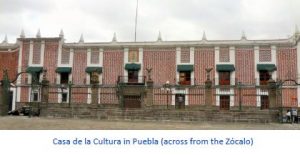 Army line of communications. These forces left in July 1848 after the Treaty of Guadalupe Hidalgo was ratified.
Army line of communications. These forces left in July 1848 after the Treaty of Guadalupe Hidalgo was ratified.
During the end of the 19th and beginning of the 20th century, Puebla remained important culturally and economically. It had a thriving textile industry at this time. Immigration from Europe was encouraged and people from Spain, Italy, Germany, France and Lebanon came to live in the city. French influence can still be seen in much of the city’s architecture. The Germans mostly settled in the Humboldt neighborhood where Bavarian style houses and the Alexander von Humboldt German College can still be found. German immigration here was one of the rea-sons Volkswagen built a large factory just outside of the city, later in the 20th century.
In what became a precursor to the Mexican Revolution, siblings Carmen, Máximo y Aquiles Serdán were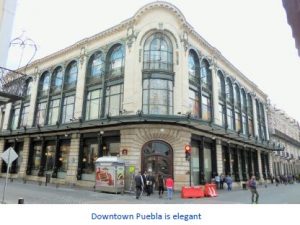 behind one of the first conspiracies against the Porfirio Diaz government. Their plans were discovered and their house, located on 6 Oriente street was surrounded by federal troops. A gun battle ensued, killing both Serdán brothers on 18 November 1910. During the Mexican Revolution, the city was taken by forces under General Pablo González Garza, then later was under Zapatista control.
behind one of the first conspiracies against the Porfirio Diaz government. Their plans were discovered and their house, located on 6 Oriente street was surrounded by federal troops. A gun battle ensued, killing both Serdán brothers on 18 November 1910. During the Mexican Revolution, the city was taken by forces under General Pablo González Garza, then later was under Zapatista control.
From 1931, until the end of the 20th century, growth of the city spurred the absorption of the municipalities of Ignacio Mariscal, San Felipe Hueyotlipan, Resurrección, San Jerónimo Caleras, San Miguel Canoa and San Francisco Totimehuacán into the city. In 1950, by decree of the state congress, the city received the title of Heroica Puebla de Zaragoza. In 1977, the federal govern-ment declared the city a Zone of Historical Monuments. In 1987, the historic center of Puebla was declared a World Heri-tage Site by UNESCO. The City of Puebla submitted its candidacy to hold the headquarters of the Free Trade Area of the Americas, and briefly served as interim secretariat headquarters until negotiations were stopped in 2005.
Cultural attractions
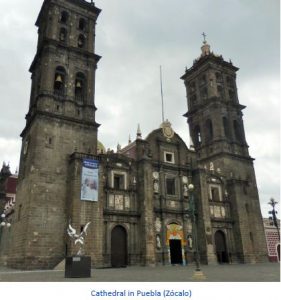 The historical and cultural value of Puebla’s architecture is a major reason the city was chosen as a World Heritage Site. Various styles and techniques such as Baroque, Renaissance and Classic are represented here in over 5,000 buildings in-cluded in the catalogue. The historic center is filled with churches, monasteries, mansions and the like, mostly done in gray cantera stone, red brick and decorated with multicolored tiles. Puebla is also considered to be the “cradle of Mexican Baroque” both in architecture and in the decorative arts, and one of the five most important colonial cities in Mexico.
The historical and cultural value of Puebla’s architecture is a major reason the city was chosen as a World Heritage Site. Various styles and techniques such as Baroque, Renaissance and Classic are represented here in over 5,000 buildings in-cluded in the catalogue. The historic center is filled with churches, monasteries, mansions and the like, mostly done in gray cantera stone, red brick and decorated with multicolored tiles. Puebla is also considered to be the “cradle of Mexican Baroque” both in architecture and in the decorative arts, and one of the five most important colonial cities in Mexico.
Cathedral of Puebla
The Cathedral, located on 16 de Septiembre and 5 Oriente, took 300 years to complete, in part due to interruptions in its construction. The Cathedral was begun in 1575 under orders of Philip II of Spain by architects Francisco Becerra and Juan de Cigorondo. The building was consecrated in 1649 even though only half of the walls and much of the roof were missing and the towers not yet built. The north tower was added in 1678 and the south tower in 1768.
Fort Loreto and Fort Guadalupe are located in the Centro Cívico 5 de Mayo part of the city. Both were 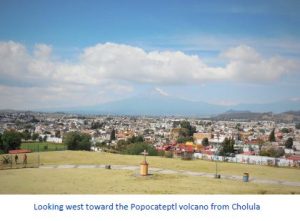 instrumental to the Battle of Puebla on 5 May 1862. The chapel of the Loreto fort contains a former chapel, which is now the Museo de la No Intervención (Museum of Non-Intervention). This is to com-memorate a non-aggression pact signed by Mexico and Central America and two South American countries in the 1960s. The Museo de Guerra del Fuerte (Fort War Museum) de Loreto y Guadalupe is located in this fort as well. This museum contains cannons, shotguns, swords, documents and other objects related to this battle.
instrumental to the Battle of Puebla on 5 May 1862. The chapel of the Loreto fort contains a former chapel, which is now the Museo de la No Intervención (Museum of Non-Intervention). This is to com-memorate a non-aggression pact signed by Mexico and Central America and two South American countries in the 1960s. The Museo de Guerra del Fuerte (Fort War Museum) de Loreto y Guadalupe is located in this fort as well. This museum contains cannons, shotguns, swords, documents and other objects related to this battle.
The Museo Amparo (Amparo Museum) is housed in two colo-nial-era buildings from the 17th and 18th centuries that were popularly known as El Hospitalito. One was the Hospital of San Juan de Letrán, which was converted into a college for women. The other is a 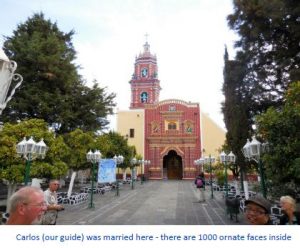 mansion from the 18th century. It was joined to the hospital and then became the “Deposito de Mujeres Casa-das” (Refuge of Married Women). This was established in 1606 for women whose husbands were gone for long periods of time. However, the idea was not popular with women and in 1609, it became the asylum for “lost women,” those obligated to be secluded for some reason. The museum has fourteen exhibition halls with pottery, steles and sculptures from the Zapotec, Huasteca, Maya, Olmec and Aztec cultures as well as fine furniture and religious objects from the colonial period and examples of contemporary art. These represent the three epochs of Mexican history, pre-Columbian, colonialera and post-Independence. Seven of the halls are dedicated to pre-Columbian pieces.
mansion from the 18th century. It was joined to the hospital and then became the “Deposito de Mujeres Casa-das” (Refuge of Married Women). This was established in 1606 for women whose husbands were gone for long periods of time. However, the idea was not popular with women and in 1609, it became the asylum for “lost women,” those obligated to be secluded for some reason. The museum has fourteen exhibition halls with pottery, steles and sculptures from the Zapotec, Huasteca, Maya, Olmec and Aztec cultures as well as fine furniture and religious objects from the colonial period and examples of contemporary art. These represent the three epochs of Mexican history, pre-Columbian, colonialera and post-Independence. Seven of the halls are dedicated to pre-Columbian pieces.
The Biblioteca Palafoxiana (Palafoxiana Library) was estab-lished in 1646 by Juan de Palafox y Mendoza 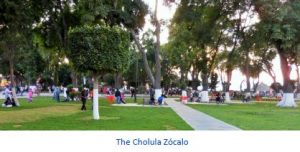 for the Seminary of Puebla. He donated his own collection of 5,000 books to the College of San Juan to start the collection. It was the first library in the Americas and is the only one to survive to the pre-sent day. The main room is in Baroque style and was constructed in 1773 by Bishop Francisco Fabian y Fuero who also named the institution after Palafox. Today the library contains over 42,000 books, 5,000 manuscripts and other items, which date from 1473 to 1910. The Library was named a Historic Monument of Mexico (Monumento Histórico de México) and UNESCO has made it part of Memory of the World.
for the Seminary of Puebla. He donated his own collection of 5,000 books to the College of San Juan to start the collection. It was the first library in the Americas and is the only one to survive to the pre-sent day. The main room is in Baroque style and was constructed in 1773 by Bishop Francisco Fabian y Fuero who also named the institution after Palafox. Today the library contains over 42,000 books, 5,000 manuscripts and other items, which date from 1473 to 1910. The Library was named a Historic Monument of Mexico (Monumento Histórico de México) and UNESCO has made it part of Memory of the World.
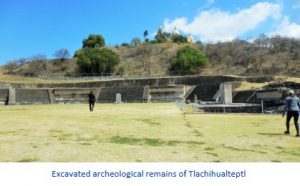 The Casa del Deán is the oldest noble house in the city of Puebla, constructed by Tomás de la Plaza Goes, who was the deacon of the Cathedral of Puebla. It was finished in 1580. The building remained practically intact until 1953, when it was going to be demolished to construct a movie theater. Protests to save the building, due to its murals and façade, succeeded. The murals are frescos, which are the only surviving non-religious examples from the 16th century in their original place in Mexico. The gray stone façade is completely smooth to let the main portal, of Renaissance style, stand out. The portal contains and upper and lower portion with a crest.
The Casa del Deán is the oldest noble house in the city of Puebla, constructed by Tomás de la Plaza Goes, who was the deacon of the Cathedral of Puebla. It was finished in 1580. The building remained practically intact until 1953, when it was going to be demolished to construct a movie theater. Protests to save the building, due to its murals and façade, succeeded. The murals are frescos, which are the only surviving non-religious examples from the 16th century in their original place in Mexico. The gray stone façade is completely smooth to let the main portal, of Renaissance style, stand out. The portal contains and upper and lower portion with a crest.
The Museo de la Revolución (Museum of the Revolution) was the home of Aquiles Serdán in the very early 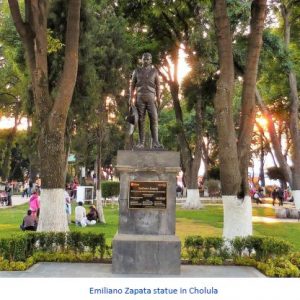 20th century. He was politically active in the anti-reelection (of President Porfirio Diaz) movement of the time and was accused of distributing propaganda against Díaz. Police assaulted the building and Serdán and his family fought back, until Aquiles was killed. President Francisco I. Madero stayed at the home in honor of Serdán. Shortly thereafter, the family moved to Mexico City and the building became tenements and stores. Decades later, the federal government acquired the building from the family to convert it into the museum that is there today.
20th century. He was politically active in the anti-reelection (of President Porfirio Diaz) movement of the time and was accused of distributing propaganda against Díaz. Police assaulted the building and Serdán and his family fought back, until Aquiles was killed. President Francisco I. Madero stayed at the home in honor of Serdán. Shortly thereafter, the family moved to Mexico City and the building became tenements and stores. Decades later, the federal government acquired the building from the family to convert it into the museum that is there today.
Other significant cultural sites include:
- The Centro Cultural Santa Rosa is housed in a building that dates from the 17th century which originally was housing for Dominican nuns
- The Galería de Arte Contemporáneo y Diseño (Gallery of Contemporary Art and Design) is dedicated to visual arts such as painting, sculpture, ceramics, metal etching, photog-raphy, video, and others and belongs to the Secretary of Culture of the state of Puebla
- The Museo de José Mariano Bello y Acedo (José Mariano Bello y Acedo Museum) was initially founded with the private collection of the Bello family, along with works donated by friends
- The Casa del Alfeñique is named for the intricate mortar work that covers its façade
- The Museo de Arte (Museum of Art) originally was con-structed to be the Temple of San Pedro, founded in 1541 to be a church and a hospital
- The Museum Workshop of Erasto Cortés Juárez was the home of one of the major figures in fine and graphic arts in Puebla in the 20th century
- The Teatro Principal de Puebla (Main Theater of Puebla) was inaugurated in 1761 by Miguel de Santamaría
- The Municipal Palace is located on Maximino Avila Camacho
- The Fountain of the China Poblana is located on Blvd He-roes de 5 de Mayo
- The Church and ex Monastery of San Francisco is on Blvd Heroes del 5 de Mayo
The Church of Santo Domingo is located on 5 de Mayo Street
Cuexcomate is the smallest volcano in the world at just thirteen meters tall and a diameter of 23 meters. The volcano is inactive and located in the La Libertad neighbor-hood of the city of Puebla. There is a spiral staircase going down into the crater itself.
Talavera Pottery
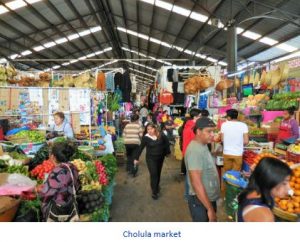 Soon after its foundation, Puebla was well known for its fine ceramics, especially for the style that would be called Talavera. This has been due to the abundance of quality clay in the re-gion, drawing some of the best artisans. Between 1550 and 1570, Spanish potters from Talavera de la Reina in Spain came to Puebla to teach the locals European techniques of using the potter’s wheel and tin-glazing. These new methods were mixed with native designs to give rise to what became known as Poblano Talavera. The glazing technique was first used for the tiles that still decorate many of the buildings in this city. Later, it was used to make pots, plates, jars, religious figures and other items. By the mid-17th century, the industry here had become well-established. Guilds were formed and ordinances passed to ensure quality. Blue was used only on the most ex-pensive pieces due to the cost of the mineral used to produce it. The period between 1650 and 1750 was known as the Golden Age.
Soon after its foundation, Puebla was well known for its fine ceramics, especially for the style that would be called Talavera. This has been due to the abundance of quality clay in the re-gion, drawing some of the best artisans. Between 1550 and 1570, Spanish potters from Talavera de la Reina in Spain came to Puebla to teach the locals European techniques of using the potter’s wheel and tin-glazing. These new methods were mixed with native designs to give rise to what became known as Poblano Talavera. The glazing technique was first used for the tiles that still decorate many of the buildings in this city. Later, it was used to make pots, plates, jars, religious figures and other items. By the mid-17th century, the industry here had become well-established. Guilds were formed and ordinances passed to ensure quality. Blue was used only on the most ex-pensive pieces due to the cost of the mineral used to produce it. The period between 1650 and 1750 was known as the Golden Age.
In 1813, the constitution eradicated the potter’s guild and re-voked the ordinances established in 1653 to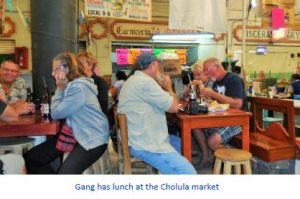 standardize pro-duction. Now anybody could use this ceramic method in any style they wanted, and the lack of regulations led to a decline in technique and artistic quality. The Talavera market crashed. Out of the 46 workshops in production since the 18th century, only seven remained. When Enrique Luis Ventosa, a 29-year old Catalan, arrived in Puebla in 1897, there were just six work-shops left. Ventosa was fascinated by the history and fine craft work that had distinguished Puebla from the rest of Mexico. He became the leading force behind a renaissance in Talavera ware.
standardize pro-duction. Now anybody could use this ceramic method in any style they wanted, and the lack of regulations led to a decline in technique and artistic quality. The Talavera market crashed. Out of the 46 workshops in production since the 18th century, only seven remained. When Enrique Luis Ventosa, a 29-year old Catalan, arrived in Puebla in 1897, there were just six work-shops left. Ventosa was fascinated by the history and fine craft work that had distinguished Puebla from the rest of Mexico. He became the leading force behind a renaissance in Talavera ware.
Another impetus to the rebirth of Puebla tile was that collectors found out about it. In 1904, an American named Emily Johnston de Forest traveled to Mexico with her husband and discovered Talavera. She established contact with scholars, collectors, and dealers who assisted her in building her collection. Eventually her collection was given to the Metropolitan Mu-seum of Art in New York City. Other museums, like the Phila-delphia Museum of Art, built their own collections. The Franz Mayer Museum in Mexico City has the largest collection of 726 pieces.
Cholula History
 Cholula is located in the Mexican highlands and, for thousands of years, it was an important trading post, connecting the Tolteca Chichimeca kingdoms in the North with the Maya in the South. At its peak, Cholula had the second-largest population in Mexico of an estimated 100,000 people living at this site. Cholula had an alliance with the neighboring city Tenochtitlán, which they shared religious services and rituals with. Conquistador Hernán Cortez discovered the alliance between Cho-lula and Tenochtitlán, and when he became aware of a plot against the Spaniards, he decided to make a preemptive attack. When Cortez, the leader of the Spanish Army, and his men arrived in Cholula on October 12, 1519, they stormed the streets, looted religious treasures, burned holy pyramids and killed 3,000 people within a few hours although some say the death toll was as much as 30,000. The massacre had the effect Cortez wanted and the people of Mexico were much more inclined to surrender. The city was believed to be incredibly sacred and the people constructed a holy pyramid for every day of the year, however, when the Spanish settled, they created one church for every day of the year as a symbol of their Christian conquest – the final touch being
Cholula is located in the Mexican highlands and, for thousands of years, it was an important trading post, connecting the Tolteca Chichimeca kingdoms in the North with the Maya in the South. At its peak, Cholula had the second-largest population in Mexico of an estimated 100,000 people living at this site. Cholula had an alliance with the neighboring city Tenochtitlán, which they shared religious services and rituals with. Conquistador Hernán Cortez discovered the alliance between Cho-lula and Tenochtitlán, and when he became aware of a plot against the Spaniards, he decided to make a preemptive attack. When Cortez, the leader of the Spanish Army, and his men arrived in Cholula on October 12, 1519, they stormed the streets, looted religious treasures, burned holy pyramids and killed 3,000 people within a few hours although some say the death toll was as much as 30,000. The massacre had the effect Cortez wanted and the people of Mexico were much more inclined to surrender. The city was believed to be incredibly sacred and the people constructed a holy pyramid for every day of the year, however, when the Spanish settled, they created one church for every day of the year as a symbol of their Christian conquest – the final touch being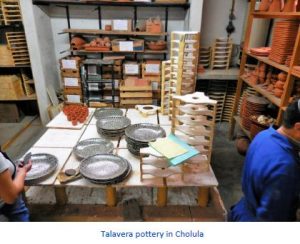 the the Iglesia de Nues-tra Señora de los Remedios on top of the Great Pyramid of Cholula.
the the Iglesia de Nues-tra Señora de los Remedios on top of the Great Pyramid of Cholula.
Great Pyramid of Cholula
The Great Pyramid of Cholula, also known as Tlachihualtepetl (Nahuatl for “artificial mountain”), is a huge complex located in Cholula, Puebla, Mexico. It is the largest archaeological site of a pyramid (temple) in the New World, as well as the largest pyramid known to exist in the world today. The pyramid is a temple that traditionally has been viewed as having been dedicated to the god, Quetzalcoatl.
The architectural style of the building was linked closely to that of Teotihuacán in the Valley of Mexico, although influence from the Gulf Coast also is evident, especially from El Tajín. The Cho-lula archaeological zone is situated 6.4 kilometres (4 mi) west of the city of Puebla, in the city of Cholula.
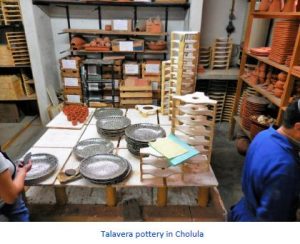 The Great Pyramid was an important religious and mythical centre in pre-hispanic times. Over a period of a thousand years prior to the Spanish Conquest, consecutive construction phases gradually built up the bulk of the pyramid until it became the largest in Mexico by volume. The temple-pyramid complex was built in four stages, starting from the 3rd century BC through the 9th century AD, and as mentioned before, was dedicated to the deity Quetzalcoatl. It has a base of 450 by 450 metres (1,480 by 1,480 ft) and a height of 66 m (217 ft). According to the Guinness Book of Records, it is, in fact, the largest pyramid as well as the largest monument ever constructed anywhere in the world, with a total volume estimated at over 4.45 million cubic metres, even larger than that of the Great Pyramid of Giza in Egypt, which is about 2.5 million cubic metres. However the Great Pyramid of Giza is higher at 138.8 metres (455 ft). The ceramics of Cholula were closely linked to those of Teotihuacán, and both sites appeared to decline simultaneously. The Postclassic Aztecs believed that Xelhua built the Great Pyramid of Cholula.
The Great Pyramid was an important religious and mythical centre in pre-hispanic times. Over a period of a thousand years prior to the Spanish Conquest, consecutive construction phases gradually built up the bulk of the pyramid until it became the largest in Mexico by volume. The temple-pyramid complex was built in four stages, starting from the 3rd century BC through the 9th century AD, and as mentioned before, was dedicated to the deity Quetzalcoatl. It has a base of 450 by 450 metres (1,480 by 1,480 ft) and a height of 66 m (217 ft). According to the Guinness Book of Records, it is, in fact, the largest pyramid as well as the largest monument ever constructed anywhere in the world, with a total volume estimated at over 4.45 million cubic metres, even larger than that of the Great Pyramid of Giza in Egypt, which is about 2.5 million cubic metres. However the Great Pyramid of Giza is higher at 138.8 metres (455 ft). The ceramics of Cholula were closely linked to those of Teotihuacán, and both sites appeared to decline simultaneously. The Postclassic Aztecs believed that Xelhua built the Great Pyramid of Cholula.
Although the pre-Hispanic city of Cholula continued to be in-habited, the Great Pyramid was abandoned in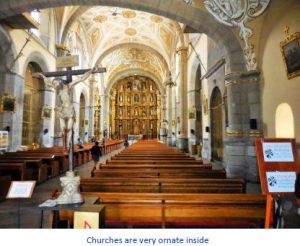 the 8th century at a time when the city suffered a drastic drop in population. By the time the Spanish arrived, the pyramid was overgrown, and by the 19th century it was still undisturbed, with only the church built in the 16th century visible. Today the pyramid at first appears to be a natural hill surmounted by a church. This is the Iglesia de Nuestra Señora de los Remedios (Church of Our Lady of Remedies), also known as the Santuario de la Virgen de los Remedios (Sanctuary of the Virgin of Remedies), which was built by the Spanish in colonial times (1594) on top of the pre-Hispanic temple. The church is a major Catholic pil-grimage destination and the site is also used for the celebration of indigenous rites. Many ancient sites in Latin America are found under modern Catholic holy sites, due to the practice of the Catholic Church of repurposing local religious sites. Because of the historic and religious significance of the church, which is a designated colonial monument, the pyramid as a whole has not been excavated and restored, as have the smaller but better known pyramids at Teotihuacán. Inside the pyramid are some five miles (8 km) of tunnels excavated by archaeologists.
the 8th century at a time when the city suffered a drastic drop in population. By the time the Spanish arrived, the pyramid was overgrown, and by the 19th century it was still undisturbed, with only the church built in the 16th century visible. Today the pyramid at first appears to be a natural hill surmounted by a church. This is the Iglesia de Nuestra Señora de los Remedios (Church of Our Lady of Remedies), also known as the Santuario de la Virgen de los Remedios (Sanctuary of the Virgin of Remedies), which was built by the Spanish in colonial times (1594) on top of the pre-Hispanic temple. The church is a major Catholic pil-grimage destination and the site is also used for the celebration of indigenous rites. Many ancient sites in Latin America are found under modern Catholic holy sites, due to the practice of the Catholic Church of repurposing local religious sites. Because of the historic and religious significance of the church, which is a designated colonial monument, the pyramid as a whole has not been excavated and restored, as have the smaller but better known pyramids at Teotihuacán. Inside the pyramid are some five miles (8 km) of tunnels excavated by archaeologists.
The first study of the pyramid area was done by Adolph Bandelier, a Swiss archaeologist with an interest in 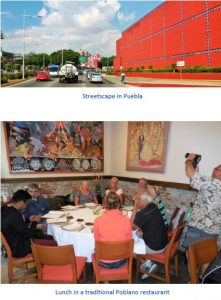 Mexico. He arrived at Cholula in 1881 and published his findings about the site in 1884. The Great Pyramid of Cholula was discovered in 1910 by construction workers building an insane asylum. Architect Ignacio Marquina started exploratory tunnelling within the pyramid in 1931. By 1954, the total length of tunnels came to approximately 8.0 kilometres (5 mi). The pyramid was excavated in two phases. The first began in 1931 and ended in the 1950s. Excavations began again in 1966 and officially ended in 1970, with the publication of the reports of the various academics who worked on Proyecto Cholula. Despite the site’s pre-Hispanic importance, this pyramid is relatively unknown and unstudied, es-pecially in comparison to others in Mexico such as Teotihuacán, Chichén Itzá and Monte Albán.
Mexico. He arrived at Cholula in 1881 and published his findings about the site in 1884. The Great Pyramid of Cholula was discovered in 1910 by construction workers building an insane asylum. Architect Ignacio Marquina started exploratory tunnelling within the pyramid in 1931. By 1954, the total length of tunnels came to approximately 8.0 kilometres (5 mi). The pyramid was excavated in two phases. The first began in 1931 and ended in the 1950s. Excavations began again in 1966 and officially ended in 1970, with the publication of the reports of the various academics who worked on Proyecto Cholula. Despite the site’s pre-Hispanic importance, this pyramid is relatively unknown and unstudied, es-pecially in comparison to others in Mexico such as Teotihuacán, Chichén Itzá and Monte Albán.
Our group spent most of the day exploring Cholula’s Great Pyramid. It was simply fascinating. First we entered the tunnels beneath the pyramid itself. Yes, this was a little claustrophobic. We visited the small museum adjacent to the pyramid. The model in the centre of the exhibit certainly helped putting the scale of the archeological site in perspective. Next, we walked the entire grounds or archaeological zone surrounding the pyramid where much of the excavation has taken place. Lastly, we climbed the pyramid, first on the walkway then finally ascending a long, steep flight of stairs. From the top, you had a stunning view of Cholula and surrounding area. We only spent four (4) days in Puebla and Cholula. Next time it will be four (4) weeks!
Download the full edition or view it online
Dan and Lisa Goy, owners of Baja Amigos RV Caravan Tours, have been making Mexico their second home for more than 30 years and love to introduce Mexico to newcomers.

